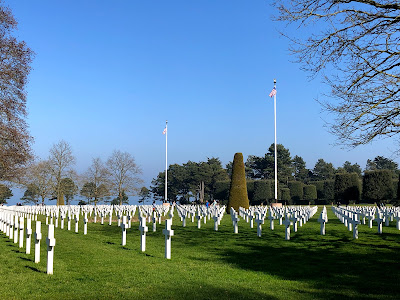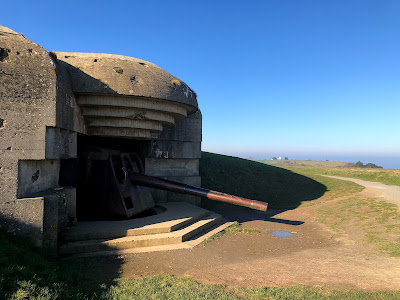 |
| Normandy American Cemetery and Memorial |
After a quick walkthrough of the Saturday Market in Bayeux, the rest of the day was dedicated to visiting some of the iconic sites related to the D-Day invasion on June 6, 1944. This historic event led to the liberation of France and was a turning point in the war against Hitler's forces.
There was a heavy price paid by 156,000 troops from the US, British and Canadian that landed on French soil that day, as well as the 200,000 more that arrived within the next four days. Today was a day for us to learn, reflect and honor all of these brave hero's, and one in particular.
 |
| A special bouquet of flowers purchased at the Bayeux Saturday Market |
The staff at the hotel suggested several key sites to visit. We inquired at the Bayeux Visitors Center as well, and they suggested the same sites, so we felt confident in our route.
We started at Arromanches-les-Baines which was a landing site for British troops. Once the site was secured troops immediately constructed a series of floating piers where ships could unload supplies and troops. Ironically they named the harbor Mulberry Harbor, although I don't think it had anything to do with honoring the small central Florida town where Beth and I lived. It's been close to seventy five years since these piers were built but there are sections remaining along the beach, as well as out in the English Channel.
 |
| Some of the remaining sections of the pier in Mulberry Harbor |
Our next stop was Longues-sur-Mur which was a German battery consisting of four large, well secured long range guns. These guns were capable of firing on targets up to twelve miles away. They fired upon approaching American and British ships the morning of the D-Day invasion, but once the Allied troops landed they were overtaken and quickly surrendered.
 |
| The remains of one of the German large gun bunkers. Note the damage incurred from incoming artillery fire. |
 |
| The view outward from inside the bunker |
We then visited the small fishing village of Port-en-Bessin-Huppain. This small port city was liberated by British troops and was part of a very ambitious undertaking called Operation PLUTO (Pipelines Under The Ocean). This operation developed a way of rapidly getting fuel from England to France by way of a pipeline that was laid on the floor of the English Channel. The pipeline worked as planned, and around 10 percent of the fuel that was delivered to support the war effort flowed through this pipeline.
 |
| Memorial to Operation PLUTO |
The next site we visited is the most well known site for Americans related to D-Day, Omaha Beach. What is now a peaceful five mile stretch of beach was the scene of a horrific battle that resulted in a tremendous loss of life of young Americans. Estimates of the total number killed or wounded that day vary, but it is estimated that around 4,000 were killed or missing and presumed dead. One young soldier said that he was the first one out of his landing craft to make it to the designated spot on the beach. The next six to follow him were either killed or injured before a second man made it safely. It's hard to imagine what that scene must have been like on that morning. Very little went as planned due to weather conditions and German resistance, but in the end the beach was secured and the liberation of France was in full swing.
 |
| Panoramic of Omaha Beach |
 |
| Memorial above Omaha Beach |
Just above Omaha Beach is a very sacred site, the Normandy American Cemetery and Memorial. This immaculate and serene setting is the final resting place for 9,387 American hero's. Each grave is marked with a white cross or Star of David. The orderly and peaceful setting is a direct contrast to the environment on the day they made the ultimate sacrifice. All of these men and women (there are four women, three of them were African American) who are buried here are remembered by around 1.5 million visitors per year, including several family members every week.
 |
| The Memorial at the Normandy American Cemetery |
 |
From Omaha Beach we drove inland to the small city of Saint-Mere-Eglise. This city has the distinction of being the first city in France to be liberated as part of the D-Day Operation. This part of the operation actually started several hours before the beach landings when over 13,000 paratroopers from the 82nd and 101st Airborne Divisions made night jumps into the area around the town. While I still wouldn't jump out of a plane now, can you imagine how much different it was back in 1944? There was no controlling the parachute, there were no night vision goggles and the equipment was bulky and cumbersome. Sadly many of these young men were killed by enemy fire before landing or died as a result of a parachute malfunction or landing in water and drowning. One young paratrooper named John Steele had the misfortune of having his parachute get tangled in the steeple of the church. He hung there for over two hours while the fighting was going on all around. Later that day he was captured by German soldiers. Thankfully he escaped three days later and rejoined his troop to continue the fight.
 |
| John Steele continues to be memorialized on the church steeple |
There are numerous museums throughout the area and all of them have very good reviews. It would be impossible to go to all the museums and sites in the same day, so we limited ourselves to one museum. Unfortunately the museum at the American Cemetery was closed for renovations. We chose the Airborne Museum in Saint-Mere-Eglise, which was outstanding. It was a series of four buildings that told the story of both the paratroopers and the thousands of ground troops that were flown into the area in small gliders.
We ended the day back along the coast of the English Channel at Utah Beach. This was the westernmost beach of the five landing beaches used during the D-Day Invasion. While lives were lost here as well, there were far fewer casualties than were suffered at Omaha Beach.
 |
| Utah Beach Memorial |
The sun was setting as we drove back to our hotel in Bayeux. We were humbled by what we saw and learned and grateful for the sacrifice of so many from what was truly the greatest generation.
If you haven't done so already, and would like to read more about Arthur's story here is a link to a previously written blog:
Honor, Sacrifice and Keeping Their Spirits Alive



